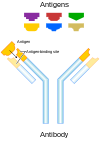
Back جسم مضاد معدل Arabic Anticòs neutralitzant Catalan Neutraliserende antistof Danish Neutralisierender Antikörper German Anticuerpo neutralizante Spanish Anticorps neutralisant French Anticorpo neutralizante Galician Anticorpo neutralizzante Italian 中和抗体 Japanese 중화 항체 Korean
 Standard antibody representation | |
| Properties | |
|---|---|
| Protein Type | Immunoglobin |
| Function | Neutralization of antigens |
| Production | B cells[1][2] |
A neutralizing antibody (NAb) is an antibody that defends a cell from a pathogen or infectious particle by neutralizing any effect it has biologically. Neutralization renders the particle no longer infectious or pathogenic.[3][4] Neutralizing antibodies are part of the humoral response of the adaptive immune system against viruses, intracellular bacteria and microbial toxin. By binding specifically to surface structures (antigen) on an infectious particle, neutralizing antibodies prevent the particle from interacting with its host cells it might infect and destroy.
- ^ Mike Recher; Karl S Lang; Lukas Hunziker; Stefan Freigang; Bruno Eschli; Nicola L Harris; Alexander Navarini; Beatrice M Senn; Katja Fink; Marius Lötscher; Lars Hangartner; Raphaël Zellweger; Martin Hersberger; Alexandre Theocharides; Hans Hengartner; Rolf M Zinkernagel (8 August 2004). "Deliberate removal of T cell help improves virus-neutralizing antibody production". Nature Immunology. 5 (9): 934–942. doi:10.1038/ni1102. PMID 15300247. S2CID 1351951.
- ^ Cite error: The named reference
Stachowiakwas invoked but never defined (see the help page). - ^ "Neutralizing antibody". Biology-Online. 2008. Retrieved 4 July 2009.
- ^ Klasse, P. J. (9 September 2014). "Neutralization of Virus Infectivity by Antibodies: Old Problems in New Perspectives". Advances in Biology. 2014: 1–24. doi:10.1155/2014/157895. PMC 4835181. PMID 27099867.
© MMXXIII Rich X Search. We shall prevail. All rights reserved. Rich X Search